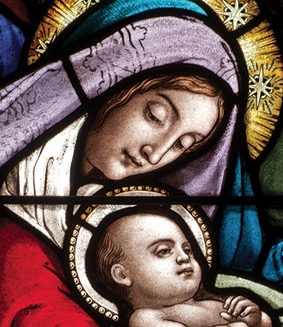The Church’s liturgical season of Christmas is one of its shortest, but also one of its most unique. Within it is the eight-day celebration of the Lord’s Nativity — known as the Christmas octave — as well as other feasts pertaining to the manifestation that Jesus is Lord of the nations. And there are feasts of several saints, many of whose stories contain special significance to the season.
The configuration of the calendar relative to the season of Christmas is a bit complex. It always begins on the solemnity of the Nativity of the Lord — Dec. 25 — and ends on the feast of the Baptism of the Lord, a movable feast roughly three weeks after Christmas.
In the U.S., Dec. 25 is always a holy day of obligation.
Christmas Day
The liturgical celebration of the Lord’s Nativity has many variables and components. There are four particular timeframes during which Mass might be celebrated in observance of this great feast: a vigil, a Mass at night, a Mass at dawn and a Mass during the day. Each of these Masses have their own unique prayers and readings. The newness of life made possible because of the Incarnation pervades the prayers and feasts of the Christmas season.
The four different Gospel readings assigned for use at the different Masses of Christmas all speak of the variety of the people affected by the Savior’s coming. The beginning of St. Matthew’s Gospel (see Mt 1:1-25), which lists Jesus’ family lineage, is proclaimed at the Vigil Mass. This includes major figures of Judaism like Abraham and David, whose covenants with God foreshadow the new and everlasting covenant that will be sealed in the blood of Christ. But Christ’s lineage also emphasizes that he came to save the poor and lowly, shown by connecting him to ancestors of low degree, socially or morally — like the four women mentioned, including David’s mistress Bathsheba. Jesus came to save them all.
The Gospel read at the Mass at night (see Lk 2:1-14) also underscores the importance of Christ’s coming for the marginalized and outcast, embodied by the news of his birth being shared firstly with the shepherds and not the rulers endowed with earthly power, who might be perceived as entitled to receiving such news on behalf of their subjects.
It is important to note that on Christmas, the faithful all are to genuflect or kneel during the Creed at the words relative to this central mystery of Christian faith, “and by the Holy Spirit was incarnate of the Virgin Mary and became man.” This helps us keep our hearts and minds focused on what the feast is all about. As the popular Christmas carol “Hark the Herald Angels Sing” phrases it, Jesus was “born that man no more may die; born to raise the sons of earth, born to give them second birth. …”
Dec. 26: Feast of St. Stephen
Within the octave are various feast days that have rich histories and traditions. It is interesting to note that the first feast day after Christmas — the very next day, Dec. 26 — is the feast of a martyr. Recalling the purpose for which Christ came and the assignment of his divine mission, Christians are reminded, at this early stage of the celebrations of the Christmas season, of the Lord’s exhortation that anyone who wishes to follow after him must take up his cross. St. Stephen, the first martyr of the Christian faith, is held up as a living witness of what it means to proclaim that Christ is savior without counting the cost.
Dec. 27: Feast of St. John
Dec. 27 is the feast of the apostle and evangelist St. John. Regarded as the disciple closest to Jesus, St. John — believed to be the author of a Gospel, the Book of Revelation and three New Testament letters — is the one who teaches us that “God is love” (1 Jn 4:8). Because St. John’s Gospel alone includes the miracle at the Cana wedding feast, when Jesus miraculously changes water into wine, this feast has long been associated with the blessing of wine.
Dec. 28: Feast of the Holy Innocents
The Holy Innocents celebrated on Dec. 28 were martyrs killed as the result of Herod’s murderous rage, resulting in his desire to eliminate any threats to his power by killing anyone who fit the profile of the newborn king he learned about from the Magi (see Mt 2:13-18). Taking no chances for the babe’s survival, he ordered the murder of all boys in or around Bethlehem under the age of 2. Christ, of course, survives thanks to the heavenly intervention manifested by the angelic admonition to St. Joseph to flee with Mary and Jesus in the middle of the night to Egypt. The Gospel proclaimed on this day, referenced above, evokes two major issues about which the Church is concerned today: immigration and abortion.
Feast of the Holy Family
Many of the few details we know of Jesus’ early life relates to his familial relationships. As a young man, we know he grew in the ways of faith as the obedient son of Mary and Joseph. The Church holds up annually the Holy Family of Nazareth as a model for all families, as a model for all human relationships. As Blessed Pope Paul VI said during a visit to the Holy Family’s town in 1964, “Nazareth is the school in which we begin to understand the life of Jesus. It is the school of the Gospel.” The feast of the Holy Family is celebrated on the Sunday after Christmas, except for the years when Christmas falls on a Sunday. Then it is celebrated on Dec. 30.
Jan. 1: Solemnity of Mary

Stained-glass image of the Virgin Mary and Jesus. Shutterstock
The octave of Christmas ends with the celebration of the Solemnity of Mary, the Holy Mother of God on Jan. 1. It is a holy day of obligation, except the obligation for Catholics in the United States is lifted when the feast falls on a Saturday or Monday. Jan. 1 also marks the Church’s commemoration of the World Day of Peace, first observed 50 years ago in 1968. It seems appropriate and fitting to be celebrated on a Marian feast day, for peace is only possible through total self-sacrifice and surrender — through total love and obedience to the will of God, of which Mary is an icon for the Church.
It bears noting that Jan. 1 previously had been known as the feast of the circumcision of the Lord, because Jewish ritual prescribes that Jewish males would have been circumcised on the eighth day after birth, in accordance with the covenant God made with Abraham. As a member of a pious, practicing Jewish family, Jesus would have received this ritual induction into the Abrahamic covenant (see Lk 2:21).
Solemnity of the Epiphany
Traditionally celebrated on Jan. 6, the Twelfth Day of Christmas, is the solemnity of the Epiphany of the Lord. The feast is transferred to the Sunday between Jan. 2-8 in the United States, however. In commemoration of Christ’s manifestation to the Magi — who represent how Christ came to save all mankind, not just the Jews — this feast celebrates how Christ’s identity is revealed, as is summed up in the gifts the Three Kings presented him. The gold and frankincense they gave Christ represent his status as king of the universe, the deity worthy of our true worship. And the myrrh tells of the bitter reality that the babe in the manger was born to die.
The Baptism of the Lord
The Christmas season ends with the feast of the Lord’s baptism, which falls on the Sunday after the Epiphany. (That is, unless the Epiphany falls on Jan. 7 or 8, when it then is celebrated on the following day, a Monday.) This feast commemorates the day on which Christ formally accepts his mission as the redeemer when he receives St. John the Baptist’s baptism of conversion and repentance. He sets out from the waters of the Jordan, identified as God’s own son by the Father’s voice that resounded from the opened sky, and inaugurates his saving work as the long-awaited Messiah who will free us of our sins.
Michael R. Heinlein is editor of Simply Catholic. Follow him on Twitter @HeinleinMichael.

